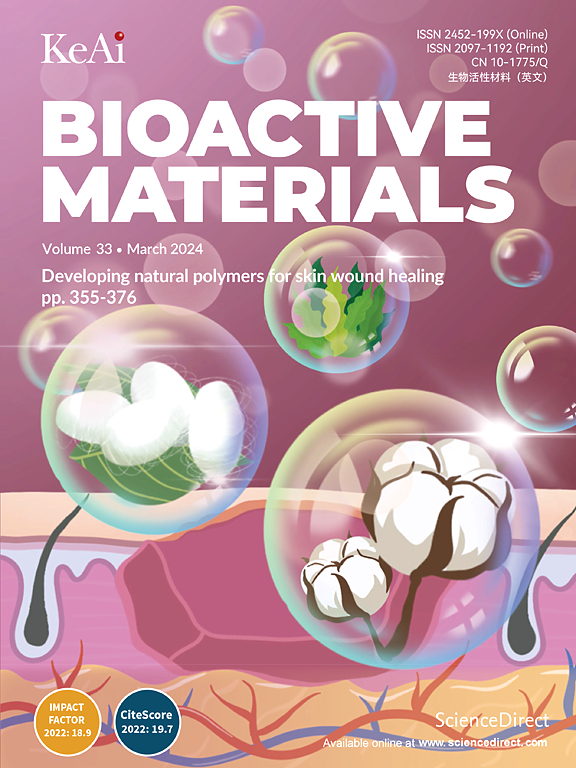TGF-β1-mRNA的局部传递可减少骨软骨缺损的纤维化。
IF 18
1区 医学
Q1 ENGINEERING, BIOMEDICAL
引用次数: 0
摘要
骨关节炎(OA)是一种影响全球数百万患者生活质量的疾病。目前的临床治疗,在大多数情况下,导致软骨修复纤维软骨组织沉积,其机械性能较差,不像透明软骨组织那样耐用。我们设计了一种mRNA递送策略,以增强自体骨髓抽吸浓缩液(BMAC)在关节软骨修复中的自然愈合潜力。我们使用矿物包被的微颗粒将TGF-β 1mrna传递到自体BMAC。将mrna激活的BMAC悬浮在外周血中产生治疗性BMAC凝块,然后将其植入兔骨软骨缺损。跟踪研究表明,凝块在缺陷中可靠地维持了至少2周。TGF-β1 mRNA表达显著增加BMAC血块中TGF-β1的产生,增加骨软骨缺损中关节软骨细胞标志物的早期表达。术后9周,与对照组相比,mrna处理的缺损具有优越的宏观软骨外观,I型胶原沉积减少,II型胶原染色强度增加,糖胺聚糖沉积面积增加。尽管治疗mRNA的短暂表达,我们已经检测到持久的效果,如纤维软骨形成的减少,由I型胶原沉积的减少和治疗组宏观外观的改善所证明。本文章由计算机程序翻译,如有差异,请以英文原文为准。

Local delivery of TGF-β1-mRNA decreases fibrosis in osteochondral defects
Osteoarthritis (OA) is a condition that affects the quality of life of millions of patients worldwide. Current clinical treatments, in most cases, lead to cartilage repair with deposition of fibrocartilage tissue, which is mechanically inferior and not as durable as hyaline cartilage tissue. We designed an mRNA delivery strategy to enhance the natural healing potential of autologous bone marrow aspirate concentrate (BMAC) for articular cartilage repair. We used mineral-coated microparticles to deliver TGF-β1 mRNA to autologous BMAC. mRNA-activated BMAC was suspended in peripheral blood to generate therapeutic BMAC clots, which were then implanted in rabbit osteochondral defects. Tracking studies revealed that the clots were reliably maintained in the defects for at least 2 weeks. TGF-β1 mRNA delivery significantly increased TGF-β1 production in BMAC clots and increased early expression of articular chondrocyte markers within osteochondral defects. At 9 weeks post-surgery, the mRNA-treated defects had a superior macroscopic cartilage appearance, decreased type I collagen deposition, increased stain intensity for type II collagen and increased glycosaminoglycan deposition area when compared to the controls. Despite the transient expression of therapeutic mRNA we have detected lasting effects, such as a decrease in fibrocartilage formation demonstrated by the decrease in type I collagen deposition and the improvement in macroscopic appearance in the treatment group.
求助全文
通过发布文献求助,成功后即可免费获取论文全文。
去求助
来源期刊

Bioactive Materials
Biochemistry, Genetics and Molecular Biology-Biotechnology
CiteScore
28.00
自引率
6.30%
发文量
436
审稿时长
20 days
期刊介绍:
Bioactive Materials is a peer-reviewed research publication that focuses on advancements in bioactive materials. The journal accepts research papers, reviews, and rapid communications in the field of next-generation biomaterials that interact with cells, tissues, and organs in various living organisms.
The primary goal of Bioactive Materials is to promote the science and engineering of biomaterials that exhibit adaptiveness to the biological environment. These materials are specifically designed to stimulate or direct appropriate cell and tissue responses or regulate interactions with microorganisms.
The journal covers a wide range of bioactive materials, including those that are engineered or designed in terms of their physical form (e.g. particulate, fiber), topology (e.g. porosity, surface roughness), or dimensions (ranging from macro to nano-scales). Contributions are sought from the following categories of bioactive materials:
Bioactive metals and alloys
Bioactive inorganics: ceramics, glasses, and carbon-based materials
Bioactive polymers and gels
Bioactive materials derived from natural sources
Bioactive composites
These materials find applications in human and veterinary medicine, such as implants, tissue engineering scaffolds, cell/drug/gene carriers, as well as imaging and sensing devices.
 求助内容:
求助内容: 应助结果提醒方式:
应助结果提醒方式:


